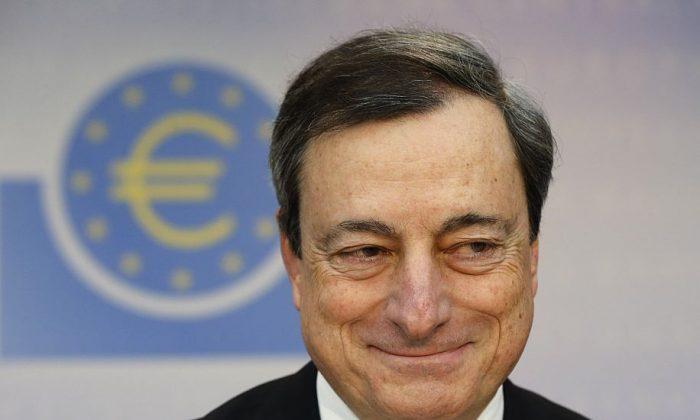Mario Draghi did get round to announcing a much-anticipated new round of quantitative easing (QE) in the end, but never have nine minutes felt so long. The world tuned into the European Central Bank press conference at 1.30pm on Thursday expecting to hear its president speak. But the clock ticked and Draghi – apparently having trouble with an elevator – was nowhere to be seen. It was enough to test the nerves of even the most hardened watchers of the eurozone. They may have to be equally patient if they want to see QE do its job.
When the press conference did begin at 1.39pm, Draghi announced that the ECB would launch an expanded asset purchase or QE programme, a trillion euro bazooka which will result in combined monthly purchases of public and private sector securities by the ECB amounting to 60 billion euros.
The programme will begin in March 2015 and continue until the end of September 2016 – or until there is a sustained adjustment in the path of inflation. The ECB has an inflation rate target below, but close to, 2% over the medium term. QE is Draghi’s big plan to make it happen.
The big question everyone is now asking is – will it work? It’s not that easy to answer. For a start, what do we mean by “work”? And how is QE supposed to work anyway?
Achievable Goals
Let’s us start with the first question. In the Q&A session which followed the press conference, Draghi repeated once again that the mandate of the ECB is price stability. In other words, the primary goal of the ECB is to bring inflation close to its 2% target, not to boost growth and employment or to bring about greater financial stability.

According to Draghi, average inflation in the eurozone for 2014 has been 0.4%, and the latest, market-based expectations for average inflation for the next five and the next ten years are at 0.3% and 0.9%, respectively. Therefore, for ECB QE to work and be successful by its own definition, then it will bring both inflation and expectations for inflation towards the 2% rate, regardless of what happens to the growth rate or the rate of unemployment in the eurozone. Be that as it may, this is not what many people in Europe (including some politicians) hope for when thinking of a successful macroeconomic policy.
Rebalancing Act
Second, how is QE supposed to work? Again, in the Q&A session, Draghi explained that QE mainly works through a portfolio rebalancing effect. It is a high-stakes game, but pretty simple in practice. The ECB buys bonds from banks which in turn use the additional money in their portfolios to increase lending to consumers and businesses.
Of course, this begs the question of why banks, which are already awash with cash, will suddenly increase lending in the credit market. Furthermore, we have the tricky question of why European consumers and businesses should demand additional credit when private and public debt is high and the prospect for growth and employment are often seen as so dire?

In reality, there is another channel QE may work: a euro depreciation. The purchase of bonds by the ECB will drive down the currency, since increasing the supply of euros makes them less attractive to hold. This should boost exports. Money will then flow in from abroad – and ultimately you get increased inflation and inflation expectations. This could also generate what are called asymmetric rebalancing effects, which essentially means cheaper exports from countries like Spain and Italy win business at the expense of those from, say, Germany.
Of course, the ECB won’t be trumpeting this possibility. It amounts to a beggar-thy-neighbour policy and Draghi would never suggest that QE work by means that tend to worsen the economic problems of other countries. It is worth noting too that QE will only produce positive effects via euro depreciation as long as there is a world demand for European goods and services (ask the Bank of England why this might not be a given), and a currency war with other countries is avoided.
It will be fascinating to see in the coming months through which channel QE produces its most telling effects. It will also be intriguing to see whether the markets and the public will measure the success of QE in the eurozone in terms of the impact it has had on jobs and growth or rather on inflation and inflation expectations. That nine-minute delay as the lifts played up may have given Draghi time ruminate on that, but now we will have to decide whether it was the prelude to a masterstroke or a desperate roll of the dice.
![]()
This article was originally published on The Conversation. Read the original article.

Friends Read Free